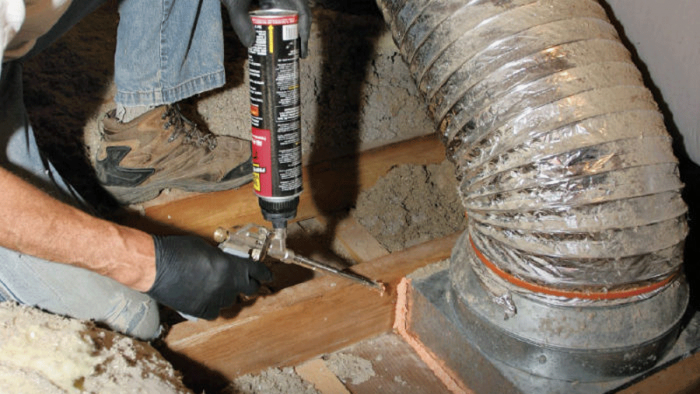Replace Cellulose with Spray Foam
Address the air leaks and convert a vented, unconditioned attic into an unvented, conditioned attic.

We have about R-45 worth of blown cellulose on the attic floor of our 100-year-old Chicago home, and a furnace and ductwork in the attic. Five years ago, we noticed condensation forming in the attic. After cleaning, we applied mildew-resistant paint and added several vents with a fan on a temperature switch. We’ve had no issues since then. However, our house gets dusty (either that or my cleanliness standards are too high). I suspect some comes from the blown cellulose in the attic or the dense-packed cellulose in the walls. I am considering having the cellulose on the attic floor removed and replaced with R-30 open-cell spray foam. Is this crazy? A contractor says that we will be better off with the foam due to its air-sealing properties, plus he can better insulate the ducts and small furnace room with the foam. Is this a good approach?
— Tutorcottage, via greenbuildingadvisor.com
Martin Holladay: While the attic fan and paint may have alleviated the symptoms of your attic moisture, they didn’t address the cause of it, or of the dust. Whoever installed cellulose on your attic floor forgot to perform air-sealing work before insulating. No matter what you do, you need to address the air leaks.
Note that spray foam won’t solve all air leakage problems—for example, air leakage around an attic access hatch needs to be addressed with weatherstripping and latches. You also don’t want to replace R-45 insulation with R-30 insulation—if you did so, you would be taking a step backward. R-30 insulation doesn’t even meet minimum code requirements.
Instead of following your contractor’s suggestion, there’s a less costly and easier approach. Remove the cellulose insulation from a section of your attic and pile it on another section. Perform your air-sealing work. Replace the insulation where it belongs, and do another section.
A full discussion of the work and materials required to air-seal an attic would require many paragraphs. Briefly, the work involves sealing leaks near plumbing chases, chimneys, kitchen soffits, attic access hatches, plumbing vent pipes, duct penetrations, electrical penetrations, and the cracks between partition top plates and partition drywall. (For more information on air-sealing, see FHB #254, pp. 54-59.)
If you do decide to install spray foam, the right place in your situation is on the underside of the roof sheathing, not on the floor. That will convert your vented, unconditioned attic into an unvented, conditioned attic, which is what you want when you have a furnace and ductwork in the attic. If you take this advice, use closed-cell spray foam, not open-cell spray foam. Research has shown that when open-cell spray foam is installed on the underside of roof sheathing, the attic and the roof sheathing can develop problems due to high humidity.
By the way, the powered attic ventilator you mention is probably adding to your energy bills by sucking away conditioned interior air through your ceiling cracks at a fast rate, and it could be endangering your family’s health by causing your gas water heater, if you have one, to backdraft. It’s also possible, although unlikely, that infiltration through your walls induced by the attic fan is introducing dust into your house. It would be best to disable your attic fan as soon as possible.
From Fine Homebuilding #270
Fine Homebuilding Recommended Products
Fine Homebuilding receives a commission for items purchased through links on this site, including Amazon Associates and other affiliate advertising programs.

Caulking Gun

Insulation Knife

Staple Gun






View Comments
Oh my. Most of this advice is good (regarding air sealing), but...
Where does it say there are heating ducts in the attic, or a gas water heater in the conditioned space? Without knowing more, one should not suggest foam under the roof. How thick are the ceiling joists/attic floor joists? Is there an attic floor?
Tutorcottage, get a 2-3 opinions from experienced local building science professionals (BPI or RESNET/HERS certified) and have them on-site to assess your actual conditions.